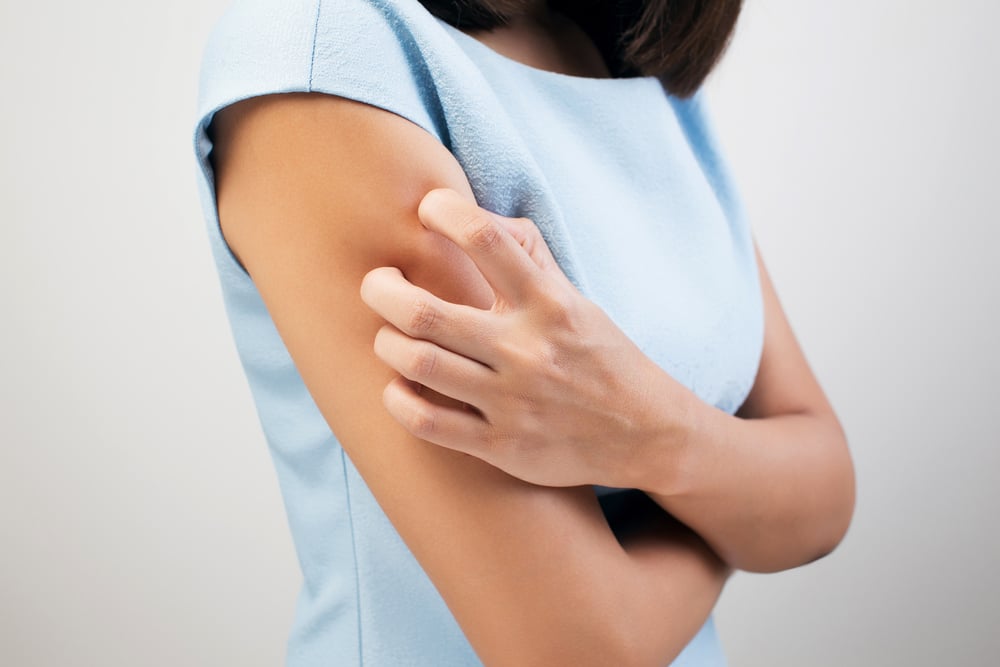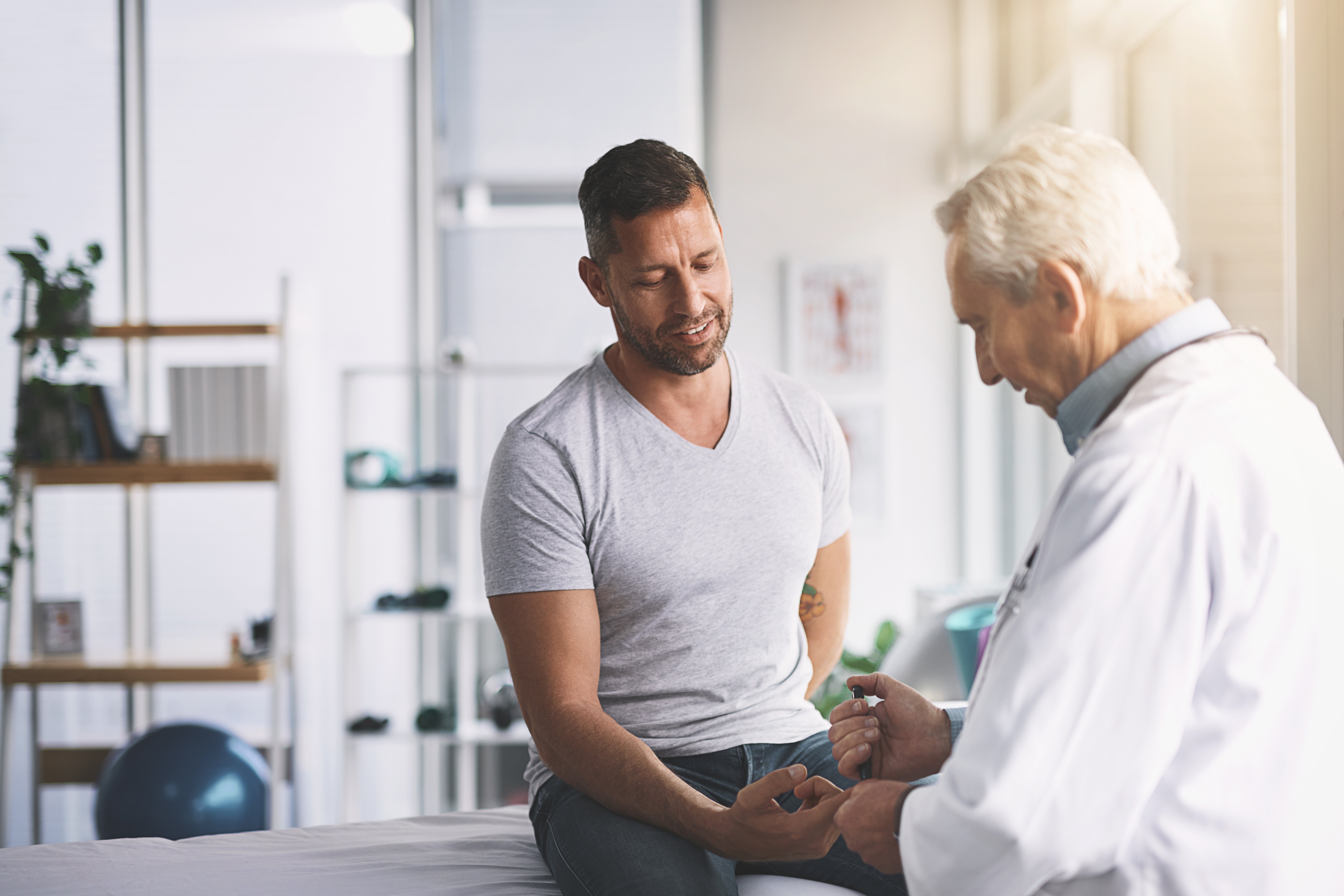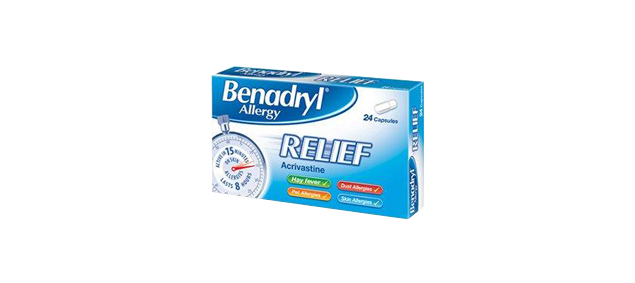Skin Allergies: Symptoms, Causes, and Treatment

Around 1 in 4 people in the UK will experience allergies at some point in their life1. Skin allergies are a particularly common example whereby the skin becomes itchy, scaly or bumpy2. Skin allergies come in various forms including3:
Hives
Contact dermatitis
Eczema.
In this article, we’ll guide you through the symptoms, causes and ways you can help manage various skin allergies.
On this page:
Skin allergy types
There are three common types of skin allergies3 and each one has slightly different symptoms or triggers.
Hives (Urticaria)
Hives, or urticaria, are raised, itchy red welts or bumps that appear on the skin2. They’re often triggered by2:
Contact dermatitis
Insect bites
Medication allergies
Foods allergies.
Hives tend to appear immediately after you’ve come into contact with an allergen and should start to fade in a few hours or days, depending on the severity of your allergy and how quickly you remove the trigger2.
Hives are usually split into two types.
Acute hives
Acute urticaria can occur upon eating specific food or coming into contact with a trigger. It can also result from other factors, such as heat, exercise, medication reactions, or insects.
Chronic hives
Chronic hives/urticaria is an ongoing reaction that many different triggers could cause. It can last for years.
Contact dermatitis
Contact dermatitis is a type of eczema triggered by contact with a particular substance or allergen4. If you’ve ever got a rash after wearing a new ring, using a different soap or changing your laundry detergent, you may have had this condition4.
Certain airborne allergens, such as pollen, can also trigger dermatitis when they come into contact with your skin2. This is known as “airborne contact dermatitis2.”
Some people find they only have a reaction after being in the sun2. This is known as “photoallergic contact dermatitis2.” It’s caused by certain chemicals commonly found in sunscreens, shaving lotion, and perfumes2.
Eczema
Eczema, or atopic dermatitis, is a chronic condition that usually starts in childhood5. The word ‘atopic’ means a sensitivity to allergens, meaning that certain triggers can cause your skin to become itchy, dry, flaky, and red5. While experts aren’t sure what the exact cause of eczema is, common triggers typically include:
Pet dander2
Dust2
Stress5
Detergents and soaps5
Certain cleaning products.2
Skin allergy symptoms

Skin allergy symptoms can vary depending on the type and severity of your allergy. Most allergy symptoms will appear within a few minutes of coming into contact with your specific trigger1.
Here’s a quick breakdown of the different signs of skin allergies and how to spot them:
Hives symptoms
Hives develop as a raised, itchy rash made of bumps or welts in many shapes and sizes2. Some people get hives all over their body, but many only develop a rash on small patches of skin6. They’re also common in both adults and children6. An itching sensation usually identifies the rash, but it may also feel like stinging or burning6.
A hives rash typically looks red against white and pale skin. But the colour is often harder to see on brown, black and darker skin tones6.
A breakout of hives should settle down within a few minutes to a few days6.
Contact dermatitis symptoms
Contact dermatitis symptoms are usually caused by an irritant that touches your skin4. In these cases, symptoms typically appear within 48 hours or, in some cases, immediately7. Some milder irritants (such as soap and detergents) may only cause symptoms after frequent exposure7.
Occasionally, the patches of skin affected by contact dermatitis can become infected7. You can spot an infection from the following signs7:
Your existing symptoms worsen
Discharge from your affected skin
Increasing pain levels
Feeling generally unwell, hot, or shivery.
Atopic eczema symptoms
Atopic eczema is a skin allergy that causes itchiness, and dry, cracked, and sore skin5. Some people only experience eczema as small patches of dry skin, but others get larger areas of inflamed skin all over the body5. Some of the more common areas affected by eczema include5:
Hands
Insides of elbows
Backs of knees
Face
Scalp (especially common in children).
Inflammation caused by eczema often looks red on lighter skin. It can be harder to spot on darker skin but usually comes up in a darker brown, purple, or grey colour5.
Skin allergy and hives causes
Skin allergies occur when your immune system reacts to a particular substance (an allergen) as though it's harmful1. It causes the release of antibodies, which results in many of the allergy symptoms we recognise – including hives2. It's unclear why some people react to specific allergens or triggers, but most people affected tend to have a family history of allergies or other closely related conditions, like asthma1.
Triggers can include:
Eating certain foods – particularly shellfish, fruit, nuts, eggs, or cow’s milk1
Skin contact with certain plants, animals, chemicals, and latex1
Cold, dry weather8
Medications, such as antibiotics or non-steroidal anti-inflammatory drugs (NSAIDs)9
Insect bites or stings1
Pressure on your skin10
Hard or heavily chlorinated water11
Stress8
Sweaty skin8
Metals in jewellery (specifically nickel and cobalt)12
Adhesives, such as the sticky substances in plasters12
Scents or fragrances found in cosmetics such as perfumes, soaps, and lipsticks12
Essential oils.12
Diagnosis of skin allergies
If you suspect you may have a skin allergy, you should speak to your GP13. They will use one or more of the following diagnostic techniques to determine whether you have a skin allergy, what might be triggering it, what type of allergy you have, and how best to treat it
Diagnosis methods for skin allergies can include:

Skin prick testing13
Skin pricking is one of the most common tests for diagnosing allergies. During the test, your doctor will drop liquid containing different allergens onto your skin. They’ll then prick the skin with a small needle. If you’re allergic to the allergen tested, your skin will develop an itchy red bump within the space of 15 minutes.
Skin pricking can be a little uncomfortable for some people, but it isn’t typically painful and is very safe.
Blood tests13
Either used alongside or instead of skin prick tests, blood tests can help diagnose a range of common allergies. Your doctor will take a sample of your blood and analyse the specific antibodies produced by your immune system in response to certain allergens.
Patch tests13
Patch tests are a common way of diagnosing contact dermatitis. They expose your skin to a specific allergen by adding a small amount of the allergen to a metal disk and then securing it to your skin for 48 hours. Your doctor will then monitor your skin for a reaction to determine whether you’re affected by it or not.
Elimination diet13
Elimination diets are a useful way of diagnosing potential food allergies. They involve reducing or removing particular foods from your diet for a few weeks, before reintroducing it and monitoring the effects this has on your body. If you notice your symptoms ease up when you remove the food from your diet and flare up again when you reintroduce it, it’s likely you have an allergy. You should only ever attempt an elimination diet with the support of a qualified healthcare professional.
Challenge testing13
Another way of diagnosing food allergies is challenge testing. During these tests, you’ll eat the food you think you’re allergic to. You’ll be asked to gradually increase the amounts you eat to see how your body reacts. Challenge testing is often thought to be the most accurate form of food allergy diagnosis but should only be carried out in a clinic under medical supervision in case you have a severe reaction.
Allergy testing kits13
Most at-home allergy kits have a lower standard than those provided by the NHS or approved clinics and so may not be completely reliable. Ideally, your allergy tests should be monitored and interpreted by your GP or another healthcare professional with knowledge of your medical history and symptoms.
Skin allergy and hives treatments
If you have a flare-up of a skin allergy or hives rash, there are several things you can do to try and manage it until your symptoms subside. Here are a few of our top tips for managing your skin allergy:
Avoid allergens
If you can identify the cause of your skin allergy, your best chance of reducing symptoms is to avoid the trigger all together or limit your exposure if complete avoidance isn’t possible2

Calm your rash
If the trigger is unavoidable, using a cool compress or a cold shower can help to calm an itchy rash. Pat dry to avoid irritating the skin even more.
Apply natural treatment
Ground down oatmeal powder mixed with water can be a good natural remedy for some people. Always mix with warm (not hot) water.
Let it breathe
Don’t wear tight clothes as these can rub and irritate your rash. Instead wear loose-fitting clothing that gives your skin space.
If you are still suffering, you may require medication. There are various allergy treatment options available, including:
Antihistamines
Emollients
Emollients are a form of moisturising treatment that help soothe dry or scaly skin15. They’re commonly used to help treat skin allergies like eczema and contact dermatitis15. Emollients come in several different forms, and it may take some trial and error before you find one that works best for you15.
You should apply a generous amount of your chosen emollient to the affected patch of skin and gently rub it in until it’s absorbed15. Make sure you smooth the emollient out in the same direction as your hair growth to avoid irritating the skin further15.
Immunotherapy
If you have a severe skin allergy, your GP may suggest immunotherapy16. This is where you’re exposed to occasional small doses of an allergen over the course of several years16. This won’t cure an allergy but can help your body become more tolerant of the allergen, so that it’s less likely to have a severe reaction to it in the future16.
Topical corticosteroids
If your skin allergy has caused your skin to become sore and inflamed, your GP may suggest using a topical corticosteroid as part of your treatment15. These can help quickly reduce the inflammation caused by your allergic reaction15. Like emollients, topical corticosteroids should be applied directly to the affected area of skin15.
Steroid tablets
If your contact dermatitis covers large areas of your body or you have hives all over your body, a topical treatment may not be suitable or practical15 16. In these instances, you might be prescribed steroid tablets to take orally15 16. The tablets will act in a similar way to other treatments, by helping to reduce the inflammation of your skin allergy16.
Phototherapy
In some cases, your GP may suggest phototherapy. This involves exposing the affected patch of skin to ultraviolet (UV) light with the intention of improving its appearance and reducing your rash15.
When to see a GP about your skin allergy
You should consult a GP about your skin allergy if:
The symptoms do not improve after two days of using at-home and OTC treatments6.
You’re worried about your hives on your child6.
The rash is spreading to more areas of the body6.
You have chronic hives (hives that keep coming back)6.
Your skin allergy is accompanied by high temperature and feeling generally unwell6.
You notice swelling under the skin – this might be a sign of angioedema6.
You have blue skin around lips – this could be a sign of anaphylaxis, which is a medical emergency that requires immediate treatment17.

Want allergy relief?
Take the quiz to find the right product to help treat your allergy symptoms.
